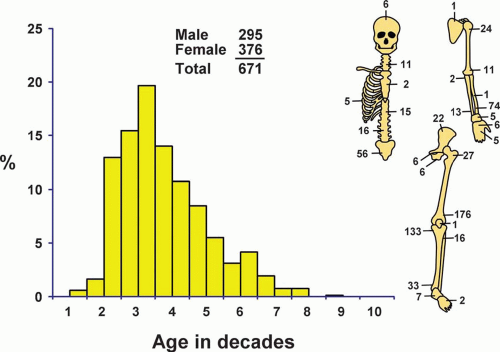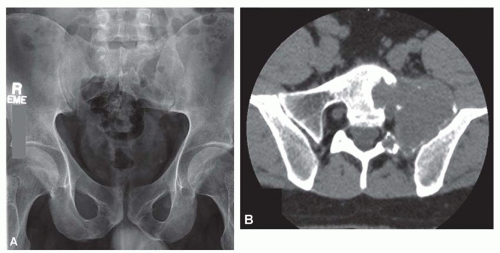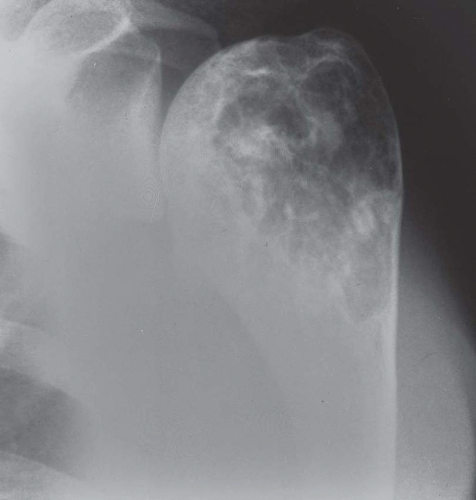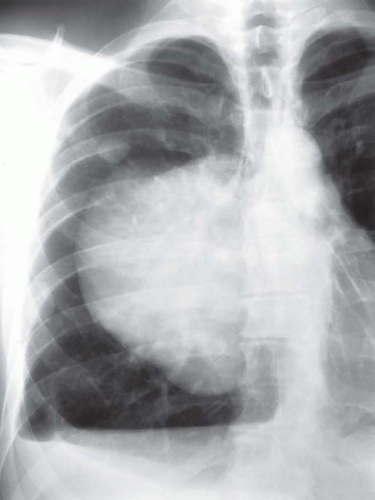Giant Cell Tumor (Osteoclastoma)
Giant cell tumor of bone is a distinctive neoplasm of undifferentiated cells. The multinucleated giant cells apparently result from fusion of the proliferating mononuclear cells, and although they are a constant and prominent part of these tumors, the giant cells are probably of less significance than the mononuclear cells. In fact, these osteoclast-like giant cells, with or without minor modification, occur in many pathologic conditions of bone. The ubiquitous giant cell accounts for the confusion that is found in the older literature and in some of the recent literature on giant cell tumors. Authors have included conditions such as metaphyseal fibrous defect, benign chondroblastoma, chondromyxoid fibroma, unicameral bone cyst with a cellular lining, giant cell reparative granuloma, aneurysmal bone cyst, hyperparathyroidism, giant cell-containing osteosarcoma, and other entities in the general category of giant cell tumor. Inclusion of these “variants” with their widely divergent biologic behavior has delayed the understanding of the clinical features and response to treatment of true giant cell tumor. The exact cell of origin of this neoplasm is still unknown. Several immunohistochemical studies have suggested that the mononuclear cells are of histiocytic origin and that the giant cells arise from their fusion.
In addition to the recognized conditions that have been confused with giant cell tumor, there are benign, often fibrogenic, rarefying processes that do not fit well into any of the known categories. These rare benign lesions, which contain giant cells and variable amounts of proliferative new bone, are likely to be found in the small bones of the hands and feet. They probably represent a peculiar reaction in bone. They fortunately are associated with a good prognosis. They have been called giant cell reaction or, more recently, giant cell reparative granuloma.
Malignant giant cell tumor, discussed in the following chapter, cannot be diagnosed with assurance unless evidence of ordinary benign giant cell tumor exists within the lesion or has been demonstrated previously at the same site. If the stromal cells of a tumor that has many benign giant cells are malignant throughout, with features of osteosarcoma, malignant fibrous histiocytoma, or fibrosarcoma, the tumor probably has no relationship to giant cell tumor. The benign giant cells are but an incidental and confusing component. The clinical correlative studies reported by Troup and coworkers in 1960 have fortified this concept.
To further confuse the issue, giant cell tumor can metastasize even though the tumor is cytologically benign. Metastasis is very rare, and only 20 examples were found in the Mayo Clinic files of 671 cases of giant cell tumor.
INCIDENCE
The 671 cases of giant cell tumor represented 6.60% of the total series and 21.87% of the benign tumors (Fig. 19.1).
SEX
In many series, females predominate. The Mayo Clinic series included 376 females and 295 males. This 56.0% of females contrasts with the 70.0% of females in the subgroup of 89 patients in the first two decades of life.
AGE
Approximately 85% of the neoplasms occurred in patients older than 19 years, with a peak incidence in the third decade of life. Only four patients were younger than 10 years, and the youngest was 8 years. Eleven patients were between the ages of 10 and 14. Only 10.88% of the patients were older than 50 years, and the oldest patient was 83 years.
LOCALIZATION
Most giant cell tumors are found at the ends (epiphyses) of long bones. Approximately 46.2% of the lesions occurred around the knee joint, with the distal femur being the most common single location. The distal end of the radius and the sacrum were the third and fourth most common locations, respectively. There were 42 lesions in the vertebrae above the level of the sacrum, and most of these involved the body of the vertebra. This finding emphasizes that in vertebrae above the sacrum “variants” are more frequent than giant cell tumors. These variants predominantly involve the posterior elements. The proximal femur is involved relatively infrequently. Four giant cell tumors involved the greater trochanter. In contrast, 6 of the 147 chondroblastomas involved the greater trochanter. The small bones of the hands and feet are rarely involved; there were seven giant cell tumors involving the tarsal bones and two involving the metatarsals. There were five tumors in the carpal bones, six in the metacarpals, and five in the phalanges of the hands. Two of the patients in this series with tumors of the small bones of the hands and feet had multicentric involvement. Information in the literature suggests that the incidence of multicentricity is higher in these sites. Multicentric involvement also may be more aggressive clinically. Five patients had involvement of the ribs and two of the sternum. Involvement of these unusual locations should suggest the possibility of other diagnoses, such as hyperparathyroidism. The pelvic bones were involved in 34 patients, and 22 of these involved the ilium. Six patients had involvement of the skull. Most involved the sphenoid. Chondroblastomas are more likely to involve the skull than giant cell tumor.
In the Mayo Clinic series, only one giant cell tumor involved the patella. However, there are several giant cell tumors of the patella in our consultation series. There is also one giant cell tumor of the hyoid bone in the consultation series. Three patients with giant cell tumors, which apparently were primary in the parotid gland, have been described. Most of the lesions with osteoclast-like giant cells, such as those noted in the pancreas, thyroid, and ovary, probably are examples of metaplastic carcinomas.
Nine patients in this series had multicentric giant cell tumor: there were 20 tumors in these 9 patients. Two patients had involvement of three separate sites, and one patient had two tumors in one bone, distal and mid radius. The other six patients had two separate skeletal sites. Two of the patients also developed pulmonary metastasis.
A few of the giant cell tumors did not extend completely to the articular cartilage, although most did. Eight patients had giant cell tumors in the metaphysis with complete sparing of the epiphysis. Six of the patients were male: 8, 16, 18, 13, 13, and 50 years old. Two were females ages 8 and 21.
SYMPTOMS
Pain of variable severity is almost always the predominant symptom. More than three-fourths of the patients had noted swelling of the affected region. Less common symptoms included weakness, limitation of motion of the joint, and signs of pathologic fracture.
PHYSICAL FINDINGS
A hard, sometimes crepitant and painful mass is found in more than 80% of the patients. Atrophy of muscles from disuse may be present as well as effusion in the adjacent joint or local heat and wetness.
RADIOGRAPHIC FEATURES
Gee and Pugh summarized the radiographic features as those of an expanding zone of radiolucency situated eccentrically, usually in the end of a long bone of an adult. The lesion usually extends to the articular cartilage, although there may be a thin zone of normal bone between the lesion and the articular cartilage. The lesion may be well marginated or poorly marginated. It is unusual to see sclerosis around a benign giant cell tumor. The tumor frequently destroys the cortex and extends into the soft tissue. Periosteal new bone formation is rarely seen. Some giant cell tumors produce large areas of destruction with poor margination, suggesting the diagnosis of malignancy. The lesion may destroy the articular cartilage and extend into the joint (Figs. 19.2, 19.3, 19.4, 19.5 and 19.6).
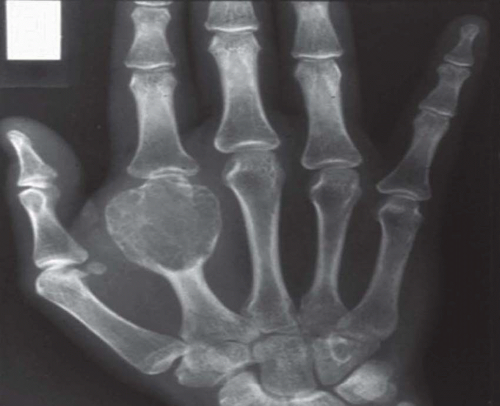 Figure 19.3. Giant cell tumor involving the proximal metacarpal bone of the index finger. The tumor is expansile and extends to the articular cartilage. |
The typical giant cell tumor produces an area of lucency with no sclerosis in it. However, rarely, a giant cell tumor may have ossification within it which may be apparent radiographically. This usually suggests the diagnosis of osteosarcoma to the radiologist (Fig. 19.7).
Although giant cell tumors classically are considered to be incapable of producing sclerosis, they typically produce a peripheral shell of ossification when they recur in soft tissue or even when they metastasize to lungs (Figs. 19.8 & 19.9). As indicated above, most giant cell tumors involve the end of the bone; however, in our series, eight were located in the metaphysis. When a giant cell tumor-like lesion occurs in a metaphysis, care should be taken to exclude an aneurysmal bone cyst and an osteosarcoma rich in giant cells.
Campanacci and coauthors have developed a grading system for giant cell tumors based on the radiographic appearance. A grade 1 tumor is associated with a well-defined margin and a thin rim of mature bone. A grade 2 tumor appears well-defined but lacks a radiopaque rim. A grade 3 lesion has fuzzy borders that suggest an aggressive neoplasm. However, Campanacci and coauthors were not able to correlate these different stages with clinical outcome (Figs. 19.3, 19.4, 19.5, 19.6, 19.7, 19.8, 19.9, 19.10 and 19.11).
Giant cell tumor may occur in a lesion of Paget disease, a rare complication that seems to have a predilection for the bones of the skull and face. Only one neoplasm in the Mayo Clinic series, an iliac tumor, developed in Paget disease.
Other lesions, most notably fibrosarcoma, may produce radiographic features similar to those of giant cell tumor.
 Figure 19.5. A: Anteroposterior plain radiograph shows a giant cell tumor forming a purely lytic expansile mass in the proximal fibula. B: Magnetic resonance imaging shows expansion into soft tissue. |
GROSS PATHOLOGIC FEATURES
The tumor tissue is characteristically soft, friable, and dark brown. Firmer portions may be seen as a result of previous fracture, treatment, or degeneration, all of which may cause fibrosis and osteoid production. Small cystic or necrotic portions, sometimes filled with blood, may be present, but these ordinarily constitute an insignificant feature of untreated lesions not modified by previous fracture. This cystification may be sufficiently prominent, especially in recurrent neoplasms, to cause them to be confused with aneurysmal bone cyst. The aggressive nature of giant cell tumors accounts for the usually immense size when they have been neglected. Intact gross specimens show variable degrees of expansion of the bone with corresponding expansion or destruction of the cortex. The rest of the osseous structure in the region of the tumor is completely replaced. The tumor practically always extends to the articular cartilage, and its boundaries are only moderately well demarcated from adjacent bone and cartilage. Even with very large lesions, the periosteum is rarely breached (Figs. 19.10, 19.11, 19.12, 19.13, 19.14, 19.15, 19.16




Stay updated, free articles. Join our Telegram channel

Full access? Get Clinical Tree


